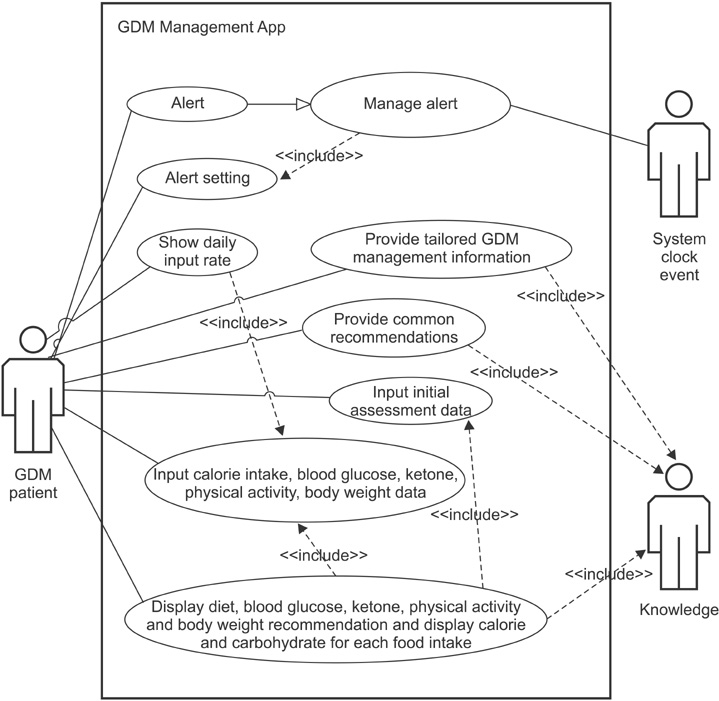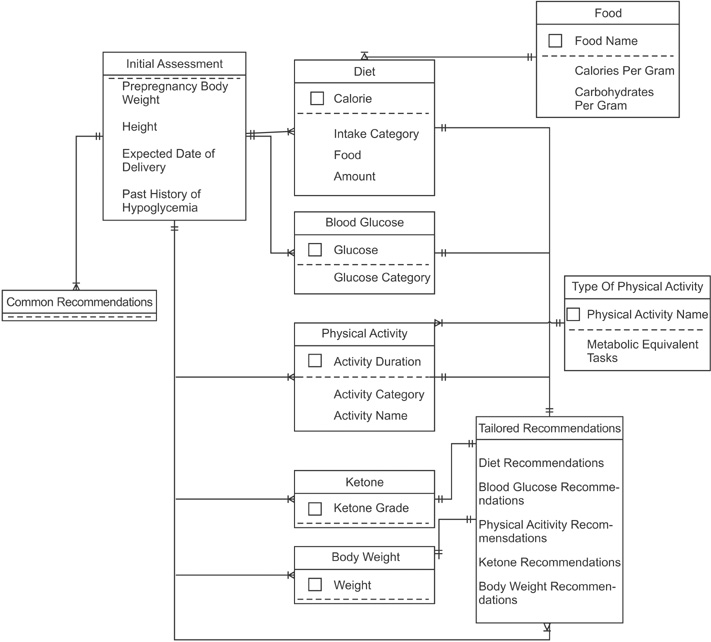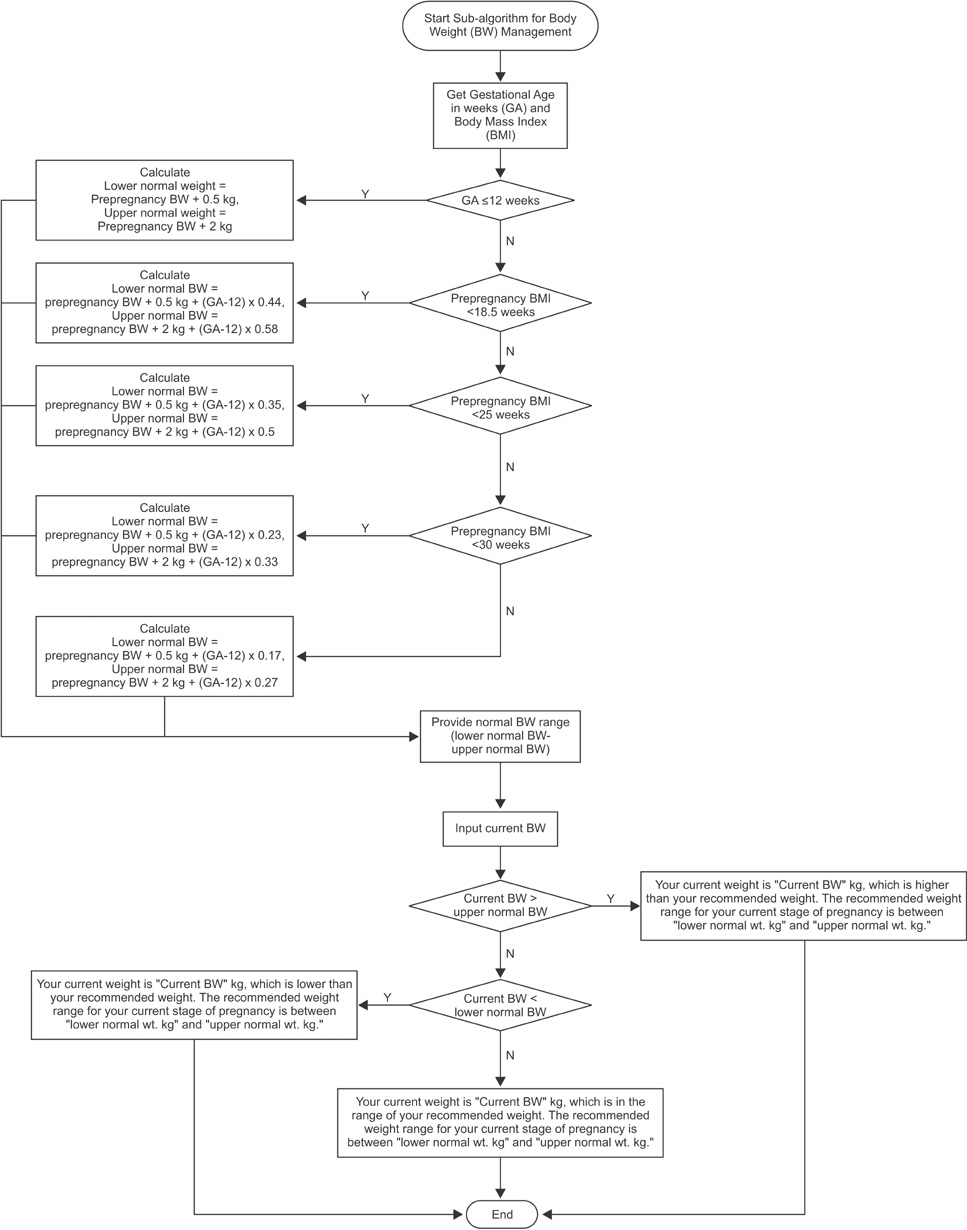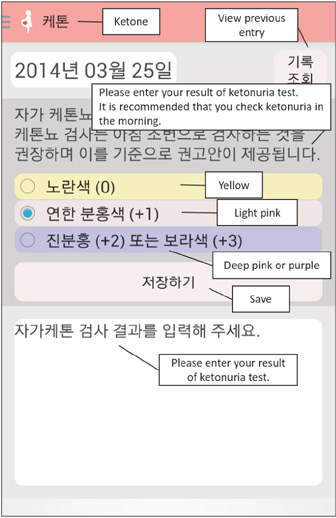Healthc Inform Res.
2016 Jan;22(1):11-21. 10.4258/hir.2016.22.1.11.
Development and Evaluation of a Smartphone Application for Managing Gestational Diabetes Mellitus
- Affiliations
-
- 1College of Nursing, Seoul National University, Seoul, Korea. hapark@snu.ac.kr
- 2Research Institute of Nursing Science, Seoul National University, Seoul, Korea.
- KMID: 2166912
- DOI: http://doi.org/10.4258/hir.2016.22.1.11
Abstract
OBJECTIVES
The purpose of this study was to develop and evaluate an application (app) that provides tailored recommendations based on lifestyle and clinical data entered by the user.
METHODS
Knowledge and functions required for the gestational diabetes mellitus (GDM) management app were extracted from clinical practice guidelines and evaluated through an online survey. Common and tailored recommendations were developed and evaluated with a content validity index. Algorithms to link tailored recommendations with a patient's data were developed and evaluated by experts. An Android-based app was developed and evaluated by comparing the process of data entry and recommendation retrieval and the usability of the app. After the app was revised, the user acceptance of the app was evaluated.
RESULTS
Six domains of knowledge and 14 functions were extracted. Seven common and 49 tailored recommendations were developed. Nine lifestyle and clinical data elements were modeled. Eight algorithms with 18 decision nodes presenting tailored recommendations based on patient's data and 12 user interface screens were developed. All recommendations obtained from the use of app concurred with recommendations derived by algorithms. The average usability score was 69.5 out of 100. The user acceptance score with behavioral intention to use was 5.5, intrinsic motivation 4.3, the perceived ease of use score was 4.6, and the perceived usefulness score was 5.0 out of 7, respectively.
CONCLUSIONS
The GDM management knowledge and tailored recommendations obtained in this study could be of help in managing GDM.
Keyword
MeSH Terms
Figure
Cited by 1 articles
-
Development and Preliminary Evaluation of Smartphone Application-Based Nutrition Education Material for Twin Pregnancy
So Yeon Kim, Ju Hee Kim
Korean J Women Health Nurs. 2018;24(1):1-13. doi: 10.4069/kjwhn.2018.24.1.1.
Reference
-
1. Expert Committee on the Diagnosis and Classification of Diabetes Mellitus. Report of the expert committee on the diagnosis and classification of diabetes mellitus. Diabetes Care. 2003; 26:Suppl 1. S5–S20.2. DeSisto CL, Kim SY, Sharma AJ. Prevalence estimates of gestational diabetes mellitus in the United States, Pregnancy Risk Assessment Monitoring System (PRAMS), 2007-2010. Prev Chronic Dis. 2014; 11:E104.
Article3. Lim N. Gestational diabetes mellitus in Korea using Korean Health Insurance Database, 2010-2011. Public Health Wkly Rep. 2013; 6(21):411–415.4. Kang HS, Lee H, Hyun MS. Trends in diabetes mellitus during pregnancy: prevalence and health care utilization. J Korean Soc Matern Child Health. 2010; 14(2):170–180.
Article5. Metzger BE, Buchanan TA, Coustan DR, de Leiva A, Dunger DB, Hadden DR, et al. Summary and recommendations of the Fifth International Workshop-Conference on Gestational Diabetes Mellitus. Diabetes Care. 2007; 30:Suppl 2. S251–S260.
Article6. Lowe LP, Metzger BE, Dyer AR, Lowe J, McCance DR, Lappin TR, et al. Hyperglycemia and Adverse Pregnancy Outcome (HAPO) Study: associations of maternal A1C and glucose with pregnancy outcomes. Diabetes Care. 2012; 35(3):574–580.7. American Diabetes Association. Standards of medical care in diabetes - 2012. Diabetes Care. 2012; 35:Suppl 1. S11–S63.8. Norris SL, Engelgau MM, Narayan KM. Effectiveness of self-management training in type 2 diabetes: a systematic review of randomized controlled trials. Diabetes Care. 2001; 24(3):561–587.9. American Association of Diabetes Educators. AADE guidelines for the practice of diabetes self-management education and training (DSME/T). Diabetes Educ. 2009; 35:3 Suppl. 85S–107S.10. Korean Diabetes Association. Treatment guideline for diabetes. Seoul: Korean Diabetes Association;2011.11. Radhakrishnan K. The efficacy of tailored interventions for self-management outcomes of type 2 diabetes, hypertension or heart disease: a systematic review. J Adv Nurs. 2012; 68(3):496–510.
Article12. Boulos MN, Wheeler S, Tavares C, Jones R. How smartphones are changing the face of mobile and participatory healthcare: an overview, with example from eCAALYX. Biomed Eng Online. 2011; 10:24.
Article13. Lee YJ, Song KB, Chung MA, Park DG. Convergence technology trends for chronic disease management. Electron Telecommun Trends. 2012; 27(5):44–54.14. Nes AA, van Dulmen S, Eide E, Finset A, Kristjansdottir OB, Steen IS, et al. The development and feasibility of a web-based intervention with diaries and situational feedback via smartphone to support self-management in patients with diabetes type 2. Diabetes Res Clin Pract. 2012; 97(3):385–393.
Article15. Kirwan M, Vandelanotte C, Fenning A, Duncan MJ. Diabetes self-management smartphone application for adults with type 1 diabetes: randomized controlled trial. J Med Internet Res. 2013; 15(11):e235.
Article16. Institute of Medicine. Weight gain during pregnancy: reexamining the guidelines. Washington (DC): National Academy of Sciences;2009.17. National Institute for Health and Care Excellence. Diabetes in pregnancy: management of diabetes and its complications from preconception to the postnatal period. London: National Institute for Health and Care Excellence;2008.18. Korean Dietetic Association. Manual of medical nutrition therapy. Seoul: Korean Dietetic Association;2008.19. Jang H. Gestational diabetes mellitus and exercise. J Korean Acad Kinesiol. 2000; 3(1):186–194.20. Son HS. Korean Diabetes Association. Diabetes. Seoul: Korea Medical Book Publisher;2011.21. Brooke J. SUS: a quick and dirty usability scale. In : Jordan PW, editor. Usability evaluation in industry. London: Taylor & Francis;1996. p. 189–194.22. Yoon J, Lim S, Cho S. An emotional gesture-based dialogue management system using behavior network. J KIISE Softw Appl. 2010; 37(10):779–787.23. Wilson EV, Lankton NK. Modeling patients' acceptance of provider-delivered e-health. J Am Med Inform Assoc. 2004; 11(4):241–248.
Article24. Davis FD, Bagozzi RP, Warshaw PR. User acceptance of computer technology: a comparison of two theoretical models. Manag Sci. 1989; 35(8):982–1003.
Article25. Davis FD, Bagozzi RP, Warshaw PR. Extrinsic and intrinsic motivation to use computers in the workplace. J Appl Soc Psychol. 1992; 22(14):1111–1132.26. Sonnenberg FA, Hagerty CG. Computer-interpretable clinical practice guidelines: where are we and where are we going? Yearb Med Inform. 2006; 2006:145–158.27. Korea Information Society Development Institute. 2012 Communications market forecast. Seoul: Korea Communications Commission;2011.28. Bangor A, Kortum P, Miller J. Determining what individual SUS scores mean: adding an adjective rating scale. J Usability Stud. 2009; 4(3):114–123.29. Guo SH, Lin YH, Chen RR, Kao SF, Chang HK. Development and evaluation of theory-based diabetes support services. Comput Inform Nurs. 2013; 31(1):17–26.
Article30. Sacks DA. Diabetes and pregnancy: a guide to a healthy pregnancy for women with type 1, type 2, or gestational diabetes. Alexandria (VA): American Diabetes Association;2011.
- Full Text Links
- Actions
-
Cited
- CITED
-
- Close
- Share
- Similar articles
-
- Gestational Diabetes Mellitus, Fetal Growth and Vitamin D
- Nutrition Care in Gestational Diabetes Mellitus
- The Importance of Early Diagnosis for Gestational Diabetes Mellitus
- The Effect of Parental Transmission of Diabetes on the Development of Gestational Diabetes Mellitus
- Cardiovascular Risk of Gestational Diabetes Mellitus






